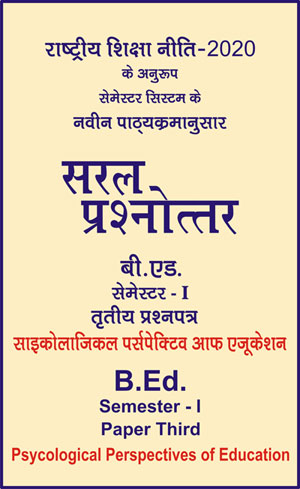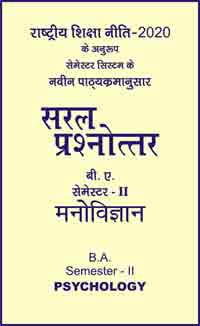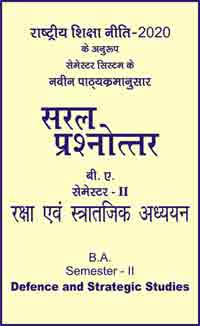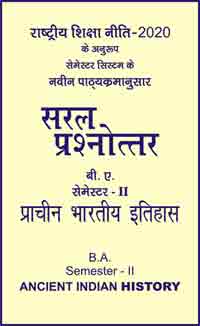|
बी एड - एम एड >> बी.एड. सेमेस्टर-1 प्रश्नपत्र-III - साइकोलाजिकल पर्सपेक्टिव आफ एजूकेशन बी.एड. सेमेस्टर-1 प्रश्नपत्र-III - साइकोलाजिकल पर्सपेक्टिव आफ एजूकेशनसरल प्रश्नोत्तर समूह
|
5 पाठक हैं |
|||||||
बी.एड. सेमेस्टर-1 प्रश्नपत्र-III - साइकोलाजिकल पर्सपेक्टिव आफ एजूकेशन (अंग्रेजी भाषा में)
Theories of Piaget, Kohlberg and Vygotsky
-
According to Piaget, a child between 2 to 7 years is in the ......... stage of cognitive development.
(a) formal operational
(b) concrete operational
(c) sensory motor
(d) pre-operational -
The process of changing the existing schemas to include new information is called:
(a) assimilation
(b) accommodation
(c) ego-centrism
(d) adaptation -
......... views children as active builders of knowledge and little scientists who construct their own theories of the world.
(a) skinner
(b) pavlov
(c) jung
(d) piaget -
Which one of the following is a correctly matched pair?
(a) concrete operational child : is able to conserve and classify
(b) formal operational child : imitation begins, imaginary play
(c) infancy : applies logic and is able to infer
(d) pre-operational child : deductive thought -
According to Piaget, children's thinking differs in ......... from adults than in ......... .
(a) amount, kind
(b) size, correctness
(c) kind, amount
(d) size, type -
Which one of the following is an example of scaffolding?
(a) giving prompts and cues and asking questions at critical junctures
(b) giving motivational lectures to students
(c) offering explanations without encouraging questioning
(d) offering both material and non-material rewards -
According to Vygotsky, children learn :
(a) when reinforcement is offered
(b) by maturation
(c) by imitation
(d) by interacting with adults and peers -
Kohlberg has given :
(a) the stages of cognitive development
(b) the stages of physical development
(c) the stages of emotional development
(d) the stages of moral development -
According to Lev Vygotsky, the primary cause of cognitive development is :
(a) social interaction
(b) adjustment of mental schemas
(c) stimulus-response pairing
(d) equilibration -
In the context of Kohlberg’s stages of moral reasoning, under which stage would the given typical response of a child fall? “Your parents will be proud of you if you are honest. So you should be honest.”
(a) social contract orientation
(b) good girl - good boy orientation
(c) law and order orientation
(d) punishment - obedience orientation -
According to Jean Piaget, which of the following is necessary for learning?
(a) observing the behavior of adults
(b) belief in imminent justice
(c) reinforcement by teachers and parents
(d) active exploration of the environment by the learner -
A 5 years old girl talks to herself while trying to fold a T-shirt. Which of the following statements is correct in the context of the behaviour displayed by the girl?
(a) Jean Piaget would explain this as egocentric speech, while Lev Vygotsky would explain this as the child’s attempt to regulate her actions through private speech
(b) Jean Piaget would explain this as social interaction, while Lev Vygotsky would explain this as an exploration
(c) Jean Piaget and Lev Vygotsky would explain this as the child’s attempt to imitate her mother
(d) Jean Piaget and Lev Vygotsky would explain this as the egocentric nature of the child’s thoughts -
According to Kohlberg, a teacher can instil moral values in children by :
(a) giving strict instructions on ‘how to behave’
(b) giving importance to religious teachings
(c) laying clear rules of behavior
(d) involving them in discussions on moral issues -
Vygotsky’s theory implies :
(a) after initial explanation, do not support a child in solving difficult questions
(b) child will learn best in the company of children having IQ lesser than his/her own
(c) collaborative problem solving
(d) individual assignments to each student -
A teacher wishes to help her students to appreciate multiple views of a situation. She provides her students multiple opportunities to debate on this situation in different groups. According to Vygotsky’s perspective, her students will ............ various views and develop multiple perspectives of the situation on their own.
(a) rationalize
(b) internalise
(c) construct
(d) operationalize -
Sita has learned to eat rice and dal with her hand. When she is given dal and rice, she mixes rice and dal and starts eating. She has ............ eating rice and dal into her schema for doing things.
(a) initiated
(b) accommodated
(c) assimilated
(d) appropriated -
Which of the following is based on Vygotsky’s socio-cultural theory?
(a) operant conditioning
(b) reciprocal teaching
(c) culture-neutral cognitive development
(d) insight learning -
A teacher says to her class, “As individual assignments are designed to help individual students learn more effectively, all students should complete assignments prescribed without any assistance”. She is referring to which of the following stages of Kohlberg’s moral development?
(a) conventional stage 4-law and order
(b) post-conventional stage 5-social contract
(c) pre-conventional stage 1-punishment
(d) pre-conventional stage 2-individualism and exchange -
Cognitive development is supported by :
(a) conducting relevant and well-defined tests as frequently as possible
(b) preserving activities that reinforce traditional methods
(c) providing a rich and varied environment
(d) focusing more on individual activities in comparison to collaboration -
In Vygotsky’s theory, which aspect of development gets neglected?
(a) social
(b) cultural
(c) biological
(d) linguistic -
Ria does not agree with Rishabh about setting up a class picnic. She thinks that the rules can be revised to suit the majority. This kind of peer disagreement, according to Piaget refers to :
(a) heteronomous morality
(b) cognitive immaturity
(c) reaction
(d) morality of cooperation -
Which of the following stages are involved when infants ‘Think’ with their eyes, ears and hands?
(a) concrete operational stage
(b) pre-operational stage
(c) sensory motor stage
(d) formal operational stage -
The teacher noticed that Pushpa cannot solve a problem on her own. However, she does so in the presence of adult or peer guidance. This guidance is called :
(a) lateralisation
(b) pre-operational thinking
(c) zone of proximal development
(d) scaffolding -
Fitting new information into existing schemas is known as :
(a) accommodation
(b) equilibration
(c) assimilation
(d) organisation -
According to Piaget’s theory, which one out of the following will not influence cognitive development?
(a) language
(b) social experiences
(c) maturation
(d) activity -
In Lawrence Kohlberg’s theory, which level signifies the absence of morality in the true sense?
(a) level III
(b) level IV
(c) level I
(d) level II -
According to the pre-conventional level of Kohlberg’s theory, to which of the following would an individual turn when making a moral decision?
(a) personal needs and desires
(b) individual values
(c) family expectations
(d) potential punishment involved -
Which one of the following statements about children would Vygotsky agree with?
(a) children learn when they are offered lucrative rewards
(b) children’s thinking can be understood by conducting laboratory experiments on animals
(c) children are born evil and need to be controlled through punishment
(d) children learn through interaction with peers and adults -
When adults adjust to the assistance they provide to facilitate the progression of the child from current level of performance to potential level of performance, it is called :
(a) scaffolding
(b) participatory learning
(c) collaborative learning
(d) proximal development -
Which one of the following statements best summarizes the relationship between development and learning as proposed by Vygotsky?
(a) Learning and development are parallel processes.
(b) Development is synonymous with learning
(c) Development process lags behind the learning process.
(d) Development is independent of learning. -
Which of the following implications cannot be derived from Piaget’s theory of cognitive development?
(a) Acceptance of individual differences
(b) Sensitivity of children’s readiness to learn
(c) Discovery learning
(d) Need of verbal teaching -
As a teacher, who firmly believes in social constructivist theory of Lev Vygotsky, which of the following methods would you prefer for assessing your students?
(a) Collaborative projects
(b) Fact-based recall questions
(c) Standardized tests
(d) Objective multiple-choice type questions -
According to Lev Vygotsky, the primary cause of cognitive development is :
(a) stimulus-response pairing
(b) social interaction
(c) adjustment of mental schemas
(d) equilibration -
In the context of Kohlberg’s stages of moral reasoning, under which stage would the given typical response of a child fall? “Your parents will be proud of you if you are honest. So you should be honest.” :
(a) Social contract orientation
(b) Punishment-obedience orientation
(c) Good girl-good boy orientation
(d) Law and order orientation -
According to Jean Piaget, which of the following is necessary for learning?
(a) Active exploration of the environment by the learner
(b) Observing the behaviour of adults
(c) Belief in immanent justice
(d) Reinforcement by teachers and parents -
According to Jean Piaget, schema building occurs as a result of modifying new information to fit existing schemes and by modifying old schemes as per new information. These two processes are known as :
(a) assimilation and adaptation
(b) accommodation and adaptation
(c) equilibration and modification
(d) assimilation and accommodation -
According to Piaget, children’s thinking differs in ......... from adults than in ......... .
(a) size, correctness
(b) amount, kind
(c) kind, amount
(d) size, type -
According to Vygotsky, children learn :
(a) by maturation
(b) when reinforcement is offered
(c) by imitation
(d) by interacting with adults and peers -
Kohlberg has given :
(a) the stages of cognitive development
(b) the stages of physical development
(c) the stages of emotional development
(d) the stages of moral development. -
According to the pre-conventional level of Kohlberg’s theory, to which of the following would an individual turn when making a moral decision?
(a) Personal needs and desires
(b) Individual values
(c) Family expectations
(d) Potential punishment involved -
Which one of the following statements about children would Vygotsky agree with?
(a) Children learn when they are offered lucrative rewards.
(b) Children’s thinking can be understood by conducting laboratory experiments on animals.
(c) Children are born ‘evil’ and need to be controlled through punishment.
(d) Children learn through social interaction with peers and adults. -
According to Piaget, a child between 2 to 7 years is in the ......... stage of cognitive development.
(a) Formal operational
(b) Concrete operational
(c) Sensorimotor
(d) Preoperational -
In Lawrence Kohlberg’s theory, which level signifies the absence of morality in the true sense?
(a) Level III
(b) Level IV
(c) Level I
(d) Level II -
In Vygotsky’s theory, which aspect of development gets neglected
(a) Social
(b) Cultural
(c) Biological
(d) Linguistic -
Which of the following is based on Vygotsky’s socio cultural theory?
(a) Operant conditioning
(b) Reciprocal teaching
(c) Culture-neutral cognitive development
(d) Insight learning -
Vygotsky emphasized the significance of the role played by which of the following factors in the learning of children?
(a) Moral
(b) Physical
(c) Social
(d) Hereditary -
A teacher makes use of a variety of tasks to cater to the different learning styles of her learners. She is influenced by :
(a) Gardner’s multiple intelligence theory
(b) Vygotsky’s socio-cultural theory
(c) Piaget’s cognitive development theory
(d) Kohlberg’s moral development theory -
According to Kohlberg, a teacher can instill moral values in children by :
(a) giving strict instructions on ‘how to behave’
(b) involving them in discussions on moral issues
(c) laying clear rules of behaviour
(d) giving importance to religious teachings -
According to Piaget’s stages of Cognitive Development, the sensori-motor stage is associated with :
(a) ability to solve problems in logical fashion
(b) concerns about social issues
(c) ability to interpret and analyse options
(d) imitation, memory and mental representation -
“Children actively construct their understanding of the world” is a statement attributed to :
(a) Piaget
(b) Kohlberg
(c) Pavlov
(d) Skinner -
The ‘insight theory of learning’ is promoted by :
(a) ‘Gestalt’ theorists
(b) Jean Piaget
(c) Pavlov
(d) Vygotsky -
Four distinct stages of children’s intellectual development are identified by :
(a) Erikson
(b) Kohlberg
(c) Skinner
(d) Piaget -
Which of the following statements describes Piaget and Vygotsky’s views on language and thought correctly?
(a) According to Vygotsky, thought emerges first and according to Piaget, language has a profound effect on thought.
(b) Both view language as emerging from the child’s thought.
(c) According to Piaget, thought emerges first and according to Vygotsky, language has a profound effect on thought.
(d) Both view thought as emerging from the child’s language. -
The concept of ‘private speech’ of children as proposed by Vygotsky
(a) shows that children are stupid and thus need guidance of adults.
(b) illustrates that children are egocentric.
(c) shows that children love themselves.
(d) illustrates that children use speech to guide their own actions. -
According to Vygotsky, learning cannot be separated from :
(a) its social context
(b) perception & attentional processes
(c) reinforcement
(d) a measurable change in behaviour -
In a constructivist classroom as envisioned by Piaget and Vygotsky, learning :
(a) is constructed by the students themselves who play an active role.
(b) is offering of reinforcement by the teacher.
(c) is dictated by the teacher and the students are passive recipients of the same
(d) happens by pairing of a stimulus and a response. -
What is a major criticism of Kohlberg’s theory?
(a) Kohlberg did not give clear cut stages of moral development
(b) Kohlberg proposed a theory without any empirical basis
(c) Kohlberg proposed that moral reasoning is developmental
(d) Kohlberg did not account for cultural differences in moral reasoning of men and women.
|
|||||














